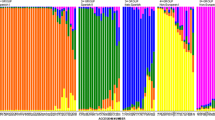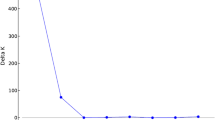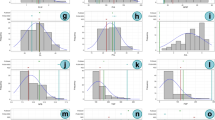Abstract
Oryza latifolia is the most abundant and widespread wild relative of rice in the lowlands of Costa Rica. It also has the most diverse morphology. However, little is known about the genetic diversity and mating system of this allotetraploid species. Genetic analyses of nine populations from different life zones from the Pacific and Atlantic slopes were performed using six isozyme loci. Differences in genetic variability were observed among populations, of which Palo Verde and Santa Rosa were the most diverse. Most Atlantic populations clustered together, and a similar result was obtained with the Pacific populations. High levels of interpopulation diversity were observed while most populations were monomorphic for at least one genotype, suggesting little genetic flow within populations. Even in polymorphic populations no variation was observed within progeny groups, combined with Hardy-Weinberg disequilibria in most populations, commonly observed in autogamous species or in species with clonal reproduction. However, the high frequency of heterozygous-like patterns may suggest that the reproductive system of O. latifolia might be more complex. Future research may explain the genetic patterns as well as the reproductive biology of this species. The knowledge of the genetic diversity and mating system of O. latifolia could contribute to the implementation of genetic resource conservation strategies and gene flow analyses, as well as of breeding programs for rice improvement.
Similar content being viewed by others
References
Alfenas A., Peters I., Brune W. and Candia G. 1991. Electroforese de proteínas e isoenzimas de fungos e essências florestais. Universidade de Vic¸osa, pp. 41–45.
Akimoto M., Shimamoto Y. and Morishima H. 1998. Population genetic structure of wild rice Oryza glumaepatula distributed in the Amazon flood area influenced by its life-history traits. Mol. Ecol. 7: 1371–1381.
Barret S.C.H and Shore J.S. 1989. Isozyme variation in colonizing plants. In: Soltis D.E. and Soltis P.S. (eds), Isozymes in Plant Biology. Dioscorides Press, Portland, Oregon.
Buso G.S.C., Rangel P.H. and Ferreira M.E. 1998. Analysis of genetic variability of South American wild rice populations (Oryza glumaepatula) with isozymes and RAPD markers. Mol. Ecol. 7: 107–117.
Cabezas E. 1998. Los orígenes del arroz en Costa Rica: 1568-1820. Informe de Investigación. Centro de Investigación en Biología Celulary Molecular. Universidad de Costa Rica. 56 pp.
Coen E. 1983. Climate. In: Janzen D.H. (ed.), Natural History of Costa Rica. University of Chicago Press, Chicago, Illinois.
Cuevas-Peréz F.E., Guimarnes E.P., Berrío L.E. and González D.I. 1992. Genetic base of irrigated rice in Latin America and the Caribbean, 1971 to 1989. Crop Sci. 32: 1054–1059.
Chern J.L. and Katayama T. 1982. Genetic analysis and geographical distribution of acid phosphatase isozyme in cultivated rice, Oryza sativa L. Jpn. J. Genet. 57: 143–153.
Chu Y. and Oka H. 1970. The genetic basis of crossing barriers between Oryza perennis subsp. Barthii and its related taxa. Evolution 24: 135–144.
Chu Y., Morishima H. and Oka H.I. 1969. Reproductive barriers distributed in cultivated rice species and their wild relatives. Jpn. J. Genet. 44: 207–223.
Falconer D.S. and Mackay T.F.C. 1996. Introduction to quantitative genetics. 4th edn. Longman Group Ltd., Essex.
Felsenstein J. 1993. PHYLIP (Phylogeny Inference Package) version 3.6. Distributed by the author. Department of Genetics, University of Washington, Seattle.
Gao L., Ge S. and Hong D. 2000. Low levels of genetic diversity within populations and high differentiation among populations of a wild rice, Oryza granulata Nees et Arn. ExWatt., from China. Int. J. Plant Sci. 161: 691–697.
Ge S., Sang T., Lu B.-R. and Hong D.-Y. 1999. Phylogeny of rice genomes with emphasis on origins of allotetraploid species. Proceedings of the National Academy of Sciences 96: 14400–14405.
Gottlieb L.D. 1982. Conservation and duplication of isozymes in plants. Science 216: 373–380.
Hartl D.S. 1987. A primer of population genetics. 2nd edn. Sinauer Associates, Inc. Publishers, Sunderland, Massachussetts.
Ikeda R., Vaughan D.A. and Kobayashi N. 1994. Landraces and wild relatives of rice as sources of useful genes. JIRCAS International Symposium Series 2: 104–111.
Jarvis D.I. and Hodgkin T. 1999. Wild relatives and crop cultivars. Detecting natural introgression and farmer selection of new genetic combinations in agroecosystems. Mol. Ecol. 8: 159–173.
Karp A., Edwards K.J., Bruford M., Funk S., Vosman B., Morgante M. et al. 1997. Molecular techniques for biodiversity evaluation: opportunities and challenges. Nat. Biotechnol. 15: 625–628.
Katayama T. 1982. Cytogenetical studies on the genus Oryza. XIII. Relationship between genomes E and D. Jpn. J. Genet. 57: 613–621.
Kaushal P. and Ravi R. 1998. Crossability of wild species of Oryza with O. sativa cvs. PR06 and Pusa Basmati for transfer of bacterial leaf blight resistance through interspecific hybridization. J. Agr. Sci. 130: 423–430.
Kaushal P., Ravi and Sidhu J.S. 1998. Screening of wild Oryza species against bacterial leaf blight (Xanthomonas oryzae pv. Oryza) pathotypes of Punjab. Plant breeding 117: 491–493.
Mann C. 1997. Reseeding the green revolution. Science 277: 1038–1943.
Martin C., Juliano A., Newbury H.J., Lu B-R., Jackson M.T. and Ford-Lloyd B.V. 1997. The use of RAPD markers to facilitate the identification of Oryza species within a germplasm collection. Genet. Resour. Crop Evol. 44: 175–183.
Oka H.I. and Morishima H. 1967. Variations in the breeding systems of a wild rice, Oryza perennis. Evolution 21: 249–258.
Pohl W.R. 1980. Flora Costaricensis, Family N° Gramineae. In: Burger W. (ed.), Fieldiana Botany. Field Museum of Natural History, pp. 680.
Poulik M.D. 1957. Starch gel electrophoresis in a discontinuous system of buffers. Nature 180: 1477–1479.
Provan J., Corbett G., McNichol J.W. and Powell W. 1997. Chloroplast DNA variability in wild and cultivated rice (Oryza spp.) revealed by polymorphic chloroplast simple sequence repeats. Genome 40: 104–110.
Ronald P. 1997. Making rice disease-resistant. Sci. Am. 100–105.
Sánchez M.E. 1999. Comparación morfológica ultraestructural de las especies silvestres de arroz (Oryza). Poaceae en Costa Rica, Universidad de Costa Rica Tesis de Licenciatura, Escuela de Biología.
Sano Y., Chu Y.E. and Oka H.I. 1979a. Genetic studies of speciation on cultivated rice, 1. Genic analysis for the F sterility between 1 O. sativa L. and O. glaberrima Steud. Jpn. J. Genet. 54: 121–132.
Sano Y., Chu Y.E. and Oka H.I. 1979b. Genetic studies of speciation on cultivated rice, Character variations in backcross derivatives between O. sativa and O. glaberrima. M-V linkage and key characters. Jpn. J. Genet. 55: 19–39.
Second G. 1982. Origin of genetic diversity of cultivated rice (Oryza spp.): study of the polymorphism scored at isozyme loci. Jpn. J. Genet. 57: 25–57.
Tanksley S.D. and McCouch S.R. 1997. Seed banks and molecular maps: unlocking genetic potential from the wild. Science 277: 1063–1066.
Tateoka T. 1962. Taxonomic studies of Oryza I. O. latifolia complex. Bot. Mag. Tokyo 75: 418–427.
Vaughan D.A. 1994. The wild relatives of rice; a genetic resources handbook. International Rice Research Institute, Manila, Philippines, 137 pp.
Wendel J.F. and Weeden N.F. 1989.Visualization and interpretation of plant isozymes. In: Soltis D.E. and Soltis P.S. (eds), Isozymes in Plant Biology. Dioscorides Press, Portland, Oregon.
Wolfe K.H. 2001. Yesterday's polyploids and the mystery of diploidization. Nat. Rev. Genet. 2: 333–341.
Xiao J., Li J., Grandillo S., Ahn S.N., Yuan L., Tanksley S. et al. 1998. Identification of trait-improving quantitative trait loci alleles from a wild rice relative, Oryza rufipogon. Genetics 150: 899–909.
Zamora A., Sánchez E., Quesada T., González P., Quesada C., Gámez R. et al. 1999. Especies silvestres, reserva de genes Útiles para el mejoramiento del arroz. Resumen de las Jornadas de Investigación de la Universidad de Costa Rica, Costa Rica, p. 37.
Zamora A. 2001. Diversidad genética y ecología de las especies silvestres de arroz en Costa Rica, M.Sc., Programa de Posgrado en Biología, Universidad de Costa Rica.
Author information
Authors and Affiliations
Rights and permissions
About this article
Cite this article
Quesada, T., Lobo, J. & Espinoza, A.M. Isozyme diversity and analysis of the mating system of the wild rice Oryza latifolia Desv. in Costa Rica. Genetic Resources and Crop Evolution 49, 633–643 (2002). https://doi.org/10.1023/A:1021240924383
Issue Date:
DOI: https://doi.org/10.1023/A:1021240924383




